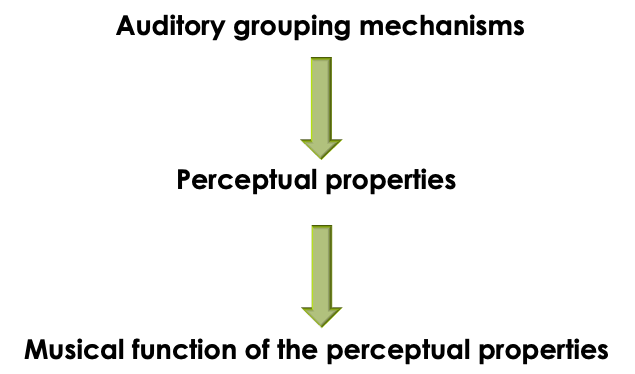Sibelius | Symphony no. 5 | TOGE Ex. 6
Example at 30:16
Score-following video
All Examples from the TOGE Article
Auditory grouping gives rise to events from which perceptual properties are extracted, which then acquire musical functions within a given sonic context
Auditory grouping processes and the resulting perceptual qualities and corresponding orchestral effects. [Adapted from Goodchild and McAdams 2021, Fig. 1]
Timbral augmentation (sustained, transforming): Wagner, Parsifal, Overture, mm. 20–25
Timbral augmentation (punctuated): Sibelius, Symphony no. 5, op. 82, iii, mm. 474–482
Timbral emergence (sustained, transforming): Schoenberg, Five Pieces for Orchestra op. 16, iii, mm. 1–11
Timbral heterogeneity (sustained, stable): Debussy, La Mer, iii, mm. 183–186.
Timbral heterogeneity (punctuated): Tchaikovsky, Nutcracker Suite, op. 71a, i, mm. 181–182
Stream integration (stable). Ravel’s orchestration of Mussorgsky’s Pictures at an Exhibition, vi (“Samuel Goldberg and Schmuÿl”), mm. 1–8, Score in C
Stream integration (transforming): Reynolds, The Angel of Death, S section, mm. 364–373; [From Touizrar and McAdams 2019]
Surface texture (transforming): Smetana, The Bartered Bride, Overture, mm. 89–99
Stream segregation (stable) of co-equal single-instrument lines: Vaughan Williams, The Lark Ascending, mm. 88–94
Example 18. Stream segregation (stable) of blended streams: Borodin, In the Steppes of Central Asia, mm. 210–218
Stream segregation (transforming) of blended streams: Stravinsky, Quatre Etudes, iv (Madrid), mm. 93–94
Stratification (stable) with three layers: Mahler, Symphony no. 1, ii, mm. 26–31
Stratification (transforming) in three layers: Borodin, In the Steppes of Central Asia, mm. 27–42]
Antiphonal contrast: Haydn, Symphony no. 100 in G major (Military), ii, mm. 61–64
Sectional boundaries: Dolan’s (2013b) orchestral graph of Haydn, Symphony no. 100, ii. Colors represent different instruments and the line thickness corresponds to notated dynamics.




























